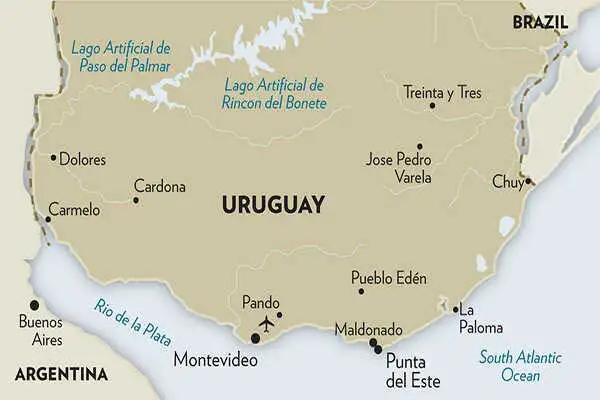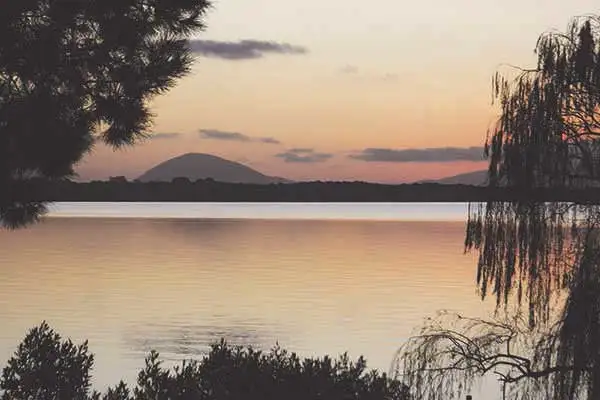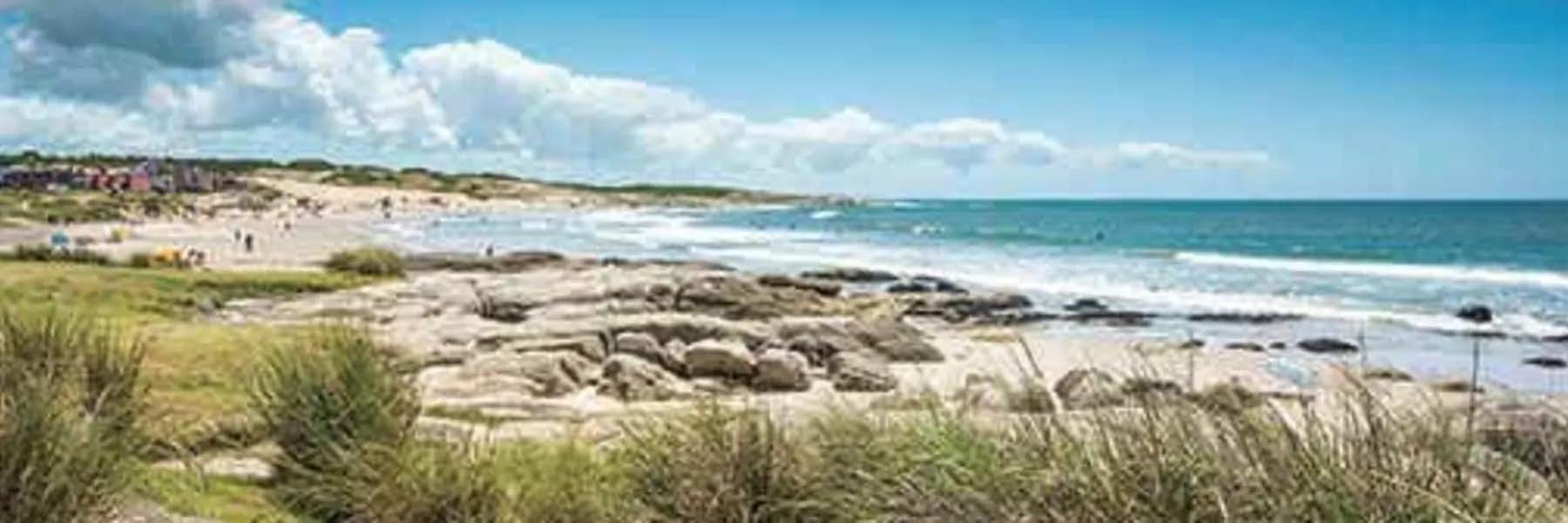One of the things I appreciate about Uruguay is just how easy it can be to live without a car.
That’s partly due to excellent neighborhood shopping at fresh markets and stores with old-style personal service. But for trips beyond walking distance, I’m an enthusiastic user of Uruguay’s superb bus system. Since I moved here in 2006, I’ve spent more than 1,000 hours riding buses. They’re the unsung hero of expat life here, and I aim to celebrate them in this article.
When I first moved here, I started out living in the beach city of Punta del Este and kept a second place in the capital, Montevideo. After seven years, I downsized and moved into my Montevideo apartment full-time, which is where I live now.
City buses in Punta del Este and Montevideo are clean, reliable, and cost about a dollar. No navigating traffic or finding a parking spot.
When I travel from city to city, or visit the countryside, I occasionally rent a car. More often, I take a cross-country bus. Most are modern motorcoaches with air conditioning, reclining seats, and large luggage bays. I can read, enjoy the scenery, or just take what I like to kid myself is an “executive power nap.” Ahem.Evenings hum to the sound of street tango and jazz.But I don’t sleep through everything. That would mean missing some of those wonderful human interactions that make travel so worthwhile. Allow me to share with you three distinct “road trips” to give you a sense for my everyday life here in Uruguay, and what you might expect if you settle here, too.
Awe on the cross-country to Treinta y Tres

When I feel like getting out of Montevideo to spend some time in the outdoors, I’m spoiled for choice. All the beaches in Uruguay are public and easily accessible. Along the southern coast, you find huge national parks and campgrounds.
Inland, the countryside is patterned with guest ranches and protected habitats. Many are near rivers, lakes, and lagoons. There are scores of opportunities to go horseback riding. Sometimes it feels like summer camp, circa 1962.
On a recent getaway, I visited the Quebrada de los Cuervos (Canyon of the Crows). It’s a large, protected habitat with the highest plant and wildlife diversity in the country. It’s in a hilly area of eastern Uruguay, 30 miles north of a small city called Treinta y Tres.
My trip started from my apartment in Montevideo’s old town. I caught the city bus #CE1 at a stop two blocks from my apartment, which took me 30 minutes to Montevideo’s main bus terminal.
Inside the terminal are dozens of bus-company ticket counters. Between them, you can buy a ticket to any city in Uruguay as well as many destinations in neighboring Argentina and Brazil.
I went to the Nuñez bus-line counter, and paid $17 for a one-way ticket to Treinta y Tres. (It’s a four-hour bus ride). My plan was to spend the night there then set out for the Quebrada de los Cuervos the next morning.
Get Your Free Report on the World's Best Places to Retire in 2026
Get Your Free Report on the World's Best Places to Retire in 2026
Simply enter your email address below to sign up for our free daily postcard e-letter and we'll also send you a FREE report on The World's Top 10 Retirement Havens for 2026.

By submitting your email address, you will receive a free subscription to IL Postcards, Overseas Dream Home, The Untourist Daily and special offers from International Living and our affiliates. You can unsubscribe at any time, and we encourage you to read more about our Privacy Policy.
It took half an hour to get past Montevideo’s city limits. Two miles out, we passed Zonamerica—an ultramodern free-trade zone with 350 international businesses set within 74 acres of manicured parks and green spaces.
After that, we drove 20 minutes through semi-rural areas until we made a stop in the small city of Pando. Beyond that last vestige of urban settlement, we entered the wide-open countryside.
Uruguay’s interior is a natural grassland, used for cattle and sheep grazing. Through the bus window, wavy green pastures, punctuated with palm trees and granite outcrops, extended to the horizon. Clouds in the huge powder-blue sky created shadows gliding across the cattle-speckled prairie.
As we rolled along, the colors of the landscape were somehow dialed up. I was glad to be making this trip. Just from looking out the window, I had already experienced a positive attitude adjustment. I felt more grateful, less self-focused, and more relaxed.

I checked my watch and saw we were scheduled to arrive in Treinta y Tres in an hour and a half. I reviewed my printout showing how to get to my Airbnb, then put my seat back, shut my eyes, and let the movement of the bus lull me into a peaceful nap. Next I knew, we were there.
I love visiting Treinta y Tres. It’s relaxing. In parts of town, such as Olimar Park, the city blends right into the rural landscape.
On summer days, children wade in the river. Families set up picnics and build barbecue fires, teens play pool by the snack bar. It’s a lovely getaway, and a great busride to get there.
Paying it forward on the #24 to Maldonado
All the beaches in Uruguay are public.Punta del Este was a coastal village that started attracting international vacationers in the 1950s. Today, it offers the highest service standards in the country both to visitors and to full-time residents. Things to do include golf, tennis, surfing, fine dining, casino shows, and visits to the world-class wineries in the countryside inland.
My first place in Uruguay was an older apartment in Punta del Este. A few months after I moved in, my kitchen fan went out. I’d learned of a good electrical shop in the neighboring town of Maldonado. So, I put the old fan in my day pack (to make sure I got the right type and size), walked to a nearby bus stop, and caught the #24 city bus to Maldonado.
Maldonado’s a middle-class city, and more practical than glitzy Punta. It was founded as a Spanish colonial city the mid-1700s, with a main plaza and cathedral. While Punta del Este and Maldonado are different, you find a wide range of interactions between them. Both are popular with expats. And the local bus service connects them, as if they were parts of the same city.
After going half a mile along the beach, the bus turns inland on Avenida Roosevelt, then chugs along the three miles to Maldonado. On each side of the avenue is a walking/bike path separated from traffic by a band of grass and trees.
It’s pretty upscale. Stops along Roosevelt include the swanky Punta Shopping mall and the driveway to the Cantegril Country Club, with its swimming pools and tennis courts. (The 18-hole golf course is three miles away.)
As we neared Maldonado’s centro, where I was headed with my fan, the bus made more turns, more stops, and more people got off. A couple just across the aisle from me looked to be in their late 20s and were speaking to each other in panicky Portuguese (a good hint that they were Brazilian). The woman held a visitor’s-information-center map and they both looked uneasy, like they could use some help.
I didn’t speak a word of Portuguese. And I was still new to the area myself. But I felt compelled to reach out to them, which I attempted in my bad Spanish. (They didn’t understand a word of it.)
Get Your Free Report on the World's Best Places to Retire in 2026
Get Your Free Report on the World's Best Places to Retire in 2026
Simply enter your email address below to sign up for our free daily postcard e-letter and we'll also send you a FREE report on The World's Top 10 Retirement Havens for 2026.

By submitting your email address, you will receive a free subscription to IL Postcards, Overseas Dream Home, The Untourist Daily and special offers from International Living and our affiliates. You can unsubscribe at any time, and we encourage you to read more about our Privacy Policy.
But by luck, they both spoke English as a second language. I learned they were vacationing in Punta del Este and going into Maldonado to try a traditional barbecue restaurant called Lo de Ruben. But they didn’t have a clue where to get off the bus.
As a second stroke of luck, I knew Lo de Ruben. It’s an insider’s sort of place many locals recommend. I’d eaten there a few times, once coming on the #24 bus.
The woman handed me the map. I took a pen from my day pack and drew the way in a dashed line. I also explained the buses going back to Punta del Este would be on a different street. And I marked that, too.
When we came to their stop, they got off and walked confidently in the right direction.
Maybe it doesn’t sound like much, but it’s moments like this that really make you feel connected to a place. Almost like...a local? As a newbie still learning my way around, I’d been in their shoes several times. And most of those times, I received help from a kind stranger.
This was the first time since I’d moved to Uruguay that I got to be the local helper as opposed to the newcomer needing help. And I liked it. I was becoming a part of the social fabric in my new home—a giver as well as a taker.
Courage on Montevideo’s city bus #121
Half of Uruguay’s population of 3.5 million lives in or near the capital, Montevideo. It’s a city known for its treelined streets, green parks, and 13-milelong coastal promenade. Shopping ranges from one-of-a-kind boutiques to spacious malls. Italian food and Mediterranean cuisine are popular, and good—the region had a lot of Italian immigration in the 20th-century, so standards are high. Evenings hum to the sounds of outdoor street tango, jazz clubs, and local symphony productions. The street tango is a sight that will stay with you forever.
Montevideo is a city comprised of 62 distinct neighborhoods. I live in Ciudad Vieja, the old part. It’s an eight-by-14-block peninsula where the city was founded in 1726. Today its pedestrianized streets are lined with shops and cafés.
One day, I was riding the city bus #121 across town to visit a friend. On the way, I heard an odd prolonged vocal sound come from near the front of the bus. We’d just pulled away from a bus stop, where several new passengers boarded.
I stretched to see the source of the noise. Standing at the head of the bus aisle, was a man I recognized. I’d seen him on the street three or four times before. He was blind. One of his hands gripped the overhead rail to keep his balance. The other held his white cane and a tips cup made from a soft drink container.
The sound he made was an attempt to sing. It’s common here for people to come onto buses to try and earn a little money from the captive audience of passengers. Some sell small inexpensive items like candy, matches, or dishtowels. Others play an instrument and/or sing for tips.
As I watched him, he tried to sing again. His second attempt was better, but his voice wandered off and then stopped.
With two failed tries and everyone’s attention now on him, he pressed his knuckles against his temples with an expression of extreme frustration.
While I felt bad for his situation, I wondered what motivated him to try singing on the bus for tips in the first place. Montevideo offers a high level of social services for those in need (including places to stay, food, medical care, and clean clothes). And if he wanted a little cash, why not just panhandle? People are usually generous to a disabled person on the street. Why was he putting himself through this?
Healthcare fees are around $50 a month.
After a long minute, the look of frustration on his face gradually transformed into one of concentration. He took some long slow breaths. And he started to sing a third time. Poorly again. But more softly.
The tone, rhythm, and lyrics of his song drifted into sync. I recognized it as a popular Uruguayan folk song. He was doing okay. And the volume of his voice slowly rose as he sang with attention and care from the beginning to the end.
During his song, I unexpectedly welled with emotion. What was going on?
Then, it dawned on me, his performance was working on two levels. On one level was the folk song itself. On a second level was the singer’s courageous effort to provide something of value, which was unfolding in front of us.
When he finished his song, the bus was quiet for a moment. Then, a woman two rows in front of me started to clap. And all the rest of us followed suit.
The singer used the overhead handrail to guide himself down the center aisle. His tip cup quickly filled—with paper money as well as coins.
At the next stop, a man helped the singer to the sidewalk while the driver waited. People are courteous here.
As the bus moved away, I looked to see the singer through the window. In one hand was his cane, tapping in front of him. In the other, he carried the cup of money he’d just earned. His head was high. His shoulders back. He walked with the gait of someone who’d overcome a hard set of circumstances to successfully (and literally) share his song with the world.
Get Your Free Report on the World's Best Places to Retire in 2026
Get Your Free Report on the World's Best Places to Retire in 2026
Simply enter your email address below to sign up for our free daily postcard e-letter and we'll also send you a FREE report on The World's Top 10 Retirement Havens for 2026.

By submitting your email address, you will receive a free subscription to IL Postcards, Overseas Dream Home, The Untourist Daily and special offers from International Living and our affiliates. You can unsubscribe at any time, and we encourage you to read more about our Privacy Policy.
Related Articles
Best Places to Live in Uruguay For Under $3,500 Per Month
